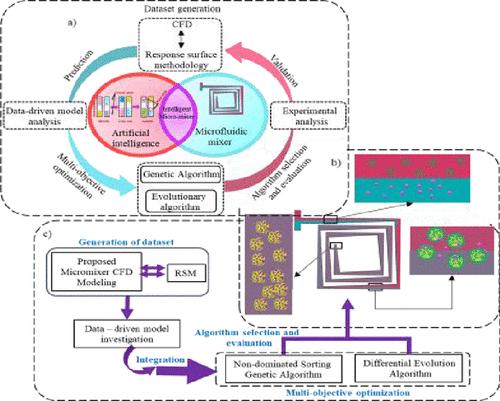当前位置:
X-MOL 学术
›
Ind. Eng. Chem. Res.
›
论文详情
Our official English website, www.x-mol.net, welcomes your feedback! (Note: you will need to create a separate account there.)
Controllable Microfluidic System through Intelligent Framework: Data-Driven Modeling, Machine Learning Energy Analysis, Comparative Multiobjective Optimization, and Experimental Study
Industrial & Engineering Chemistry Research ( IF 3.8 ) Pub Date : 2024-06-27 , DOI: 10.1021/acs.iecr.4c00456 Afshin Kouhkord 1 , Faridoddin Hassani 2 , Moheb Amirmahani 1 , Ali Golshani 3 , Naser Naserifar 1 , Farhad Sadegh Moghanlou 2 , Ali Tarlani Beris 4
Industrial & Engineering Chemistry Research ( IF 3.8 ) Pub Date : 2024-06-27 , DOI: 10.1021/acs.iecr.4c00456 Afshin Kouhkord 1 , Faridoddin Hassani 2 , Moheb Amirmahani 1 , Ali Golshani 3 , Naser Naserifar 1 , Farhad Sadegh Moghanlou 2 , Ali Tarlani Beris 4
Affiliation

|
Intelligent microfluidics in nanoparticle synthesis embodies a comprehensive synergistic approach that merges numerical modeling, artificial intelligence, and experimental analysis, striving for controllability over an energy-efficient microfluidic device designed for nanoparticle synthesis with desired physical properties. This study delves into a microfluidic mass transfer system, employing an innovative methodology that combines data-driven modeling, machine learning-based comparative multiobjective optimization, and experimental analysis to model a micromixing system. A surrogate data-driven model is employed to the microfluidic mass transfer system, considering four critical geometrical parameters and inlet Reynolds as design variables. The model provides insights into mixer’s functionality. It is observed that at lower Reynolds numbers, increasing NoT increases the mixing efficiency by more than 20%. Moreover, altering SNDi value leads to a significant 80% reduction in pressure drop. Identifying the optimal system from numerous design parameters is challenging but accomplished through machine learning. Two distinct machine learning algorithms were integrated with mathematical surrogate modeling to optimize the mixer for three objectives. RSM-Differential Evolution significantly outperforms RSM-NSGA-II in enhancing mixing characteristics and reducing the mechanical energy consumption by over 85%. Additionally, improvement in energy dissipation and effective energy efficiency of microsystem was made, alongside a comparable enhancement of mixing index and management of pressure drop. Fabrication of two optimal designs confirms an over 80% drop in pressure and an increase in mixing efficiency by over 20% at low Reynolds, outperforming conventional microfluidic mixers. The intelligent micromixer allows precise control over nanoparticle synthesis by adjusting microtransfer design parameters. This controlled process is crucial for tissue engineering hydrogel synthesis, nanotechnology, and targeted drug delivery.
中文翻译:

通过智能框架控制微流控系统:数据驱动建模、机器学习能量分析、比较多目标优化和实验研究
纳米颗粒合成中的智能微流控体现了一种综合的协同方法,融合了数值建模、人工智能和实验分析,力求为纳米颗粒合成设计具有所需物理性质的节能微流控装置的可控性。本研究深入研究微流体传质系统,采用创新方法,结合数据驱动建模、基于机器学习的比较多目标优化和实验分析来建模微混合系统。微流体传质系统采用替代数据驱动模型,考虑四个关键几何参数和入口雷诺作为设计变量。该模型提供了对混频器功能的深入了解。据观察,在较低的雷诺数下,增加 NoT 可使混合效率提高 20% 以上。此外,改变 SND 值会导致压降显着降低 80%。从众多设计参数中识别最佳系统具有挑战性,但可以通过机器学习来完成。将两种不同的机器学习算法与数学代理建模相集成,以优化混合器的三个目标。 RSM-Differential Evolution 在增强混合特性和降低机械能耗方面显着优于 RSM-NSGA-II 85% 以上。此外,微系统的能量耗散和有效能源效率得到了改善,同时混合指数和压降管理也得到了相当程度的提高。两种优化设计的制造证实,在低雷诺数下,压力下降了 80% 以上,混合效率提高了 20% 以上,优于传统的微流体混合器。 智能微混合器可以通过调整微转移设计参数来精确控制纳米粒子的合成。这种受控过程对于组织工程水凝胶合成、纳米技术和靶向药物输送至关重要。
更新日期:2024-06-29
中文翻译:

通过智能框架控制微流控系统:数据驱动建模、机器学习能量分析、比较多目标优化和实验研究
纳米颗粒合成中的智能微流控体现了一种综合的协同方法,融合了数值建模、人工智能和实验分析,力求为纳米颗粒合成设计具有所需物理性质的节能微流控装置的可控性。本研究深入研究微流体传质系统,采用创新方法,结合数据驱动建模、基于机器学习的比较多目标优化和实验分析来建模微混合系统。微流体传质系统采用替代数据驱动模型,考虑四个关键几何参数和入口雷诺作为设计变量。该模型提供了对混频器功能的深入了解。据观察,在较低的雷诺数下,增加 NoT 可使混合效率提高 20% 以上。此外,改变 SND 值会导致压降显着降低 80%。从众多设计参数中识别最佳系统具有挑战性,但可以通过机器学习来完成。将两种不同的机器学习算法与数学代理建模相集成,以优化混合器的三个目标。 RSM-Differential Evolution 在增强混合特性和降低机械能耗方面显着优于 RSM-NSGA-II 85% 以上。此外,微系统的能量耗散和有效能源效率得到了改善,同时混合指数和压降管理也得到了相当程度的提高。两种优化设计的制造证实,在低雷诺数下,压力下降了 80% 以上,混合效率提高了 20% 以上,优于传统的微流体混合器。 智能微混合器可以通过调整微转移设计参数来精确控制纳米粒子的合成。这种受控过程对于组织工程水凝胶合成、纳米技术和靶向药物输送至关重要。











































 京公网安备 11010802027423号
京公网安备 11010802027423号